Install the app
How to install the app on iOS
Follow along with the video below to see how to install our site as a web app on your home screen.
Note: This feature may not be available in some browsers.
You are using an out of date browser. It may not display this or other websites correctly.
You should upgrade or use an alternative browser.
You should upgrade or use an alternative browser.
Panssarivaunut
- Viestiketjun aloittaja ctg
- Aloitus PVM
-
- Tagit
- panssarivaunut
GTI on eilispäivää kuuluu tämän kommentti.
Huhta
Greatest Leader
Mielenkiintoista. Olivatko Abramsit ainoastaan sivuloikka?
Leopard, Abrams, K2... siinä alkaa olla melkoinen valikoima vaunuja yhdelle maalle.
Huhta
Greatest Leader
Miten olisi Pantteripäivitys osalle meidän A4:ia muiden poistuessa tai mennessä T-55 runkojen tilalle. Joku kenraalihan hiljattain kommentoi oudosti että A7V on liian painava, katsotaan mitä sieltä tulee seuraavaksi
Puolalaisille on varmaan selvinnyt varsin hyvin ettei saksasta kannata ostaa asemateriaalia. . .
Tämä Saksan penseys on tosiaan kysymysmerkki meillekin. Vaikka periaatteessa tällaisia järjestelmiä hankittaessa pitäisikin huolehtia siitä, että ylläpitoon tarvittavat kyvyt ja materiaali löytyvät omasta takaa, niin sota-ajan täydennyksien varaan ei ilmeisesti kannata liikaa laskea nykyisen Saksan kanssa.
Sinänsä Leopard 2A4:n kohtaloa kannattaa pohtia varmaan vasta, kun Nato-jäsenyydestä ollaan paremmin kartalla. Päivitykset (saati uudet vaunut) olisivat kalliita ja pois jostakin muualta. Samaan aikaan mahdolliset Nato-vahvistukset olisivat luultavammin mekanisoituja joukkoja kuin mitään hirviprikaati-porukkaa.
Toisaalta jos Nato-jäsenyys jää roikkumaan pidemmäksi aikaa, niin voi olla, että lisäbudjetteja joudutaan tekemään lisääkin nykyisten päälle. Silloin kysymyksestä tulee ajankohtaisempi. Mutta onko ratkaisu silloinkaan Leopard-päivitys vaiko jotakin muuta? Uusinkin Abrams olisi joiltakin osin downgrade nykyiseen Leopard 2A6:een nähden, vaikka Puola tähän päätyikin. Mutta K2 Black Panther saattaa olla kilpailukykyisesti hinnoiteltu ja siinä on joitakin kiinnostavia ominaisuuksia (mm. automaattilaturi, omasuojajärjestelmät, adaptiivinen jousitus, varusmiesarmeija-yhteensopivuus) - riippuen toki hieman siitä, miten vaunun kanssa käy lopulta Puolassa ja Norjassa (Wikipedian mukaan Norjassa on vastakkain Leo 2A7 ja K2, päätöstä odotetaan loppuvuodesta 2022).
Ainakin tuossa tilanteessa ihan jämäyttäisin puolustusbudjetin vähintään 2,5% BKT:sta tasolle odottamaan NATO-hommien etenemistä. Tarkoituksena olisi tietty tehdä jo olemassa olevan suorituskyvyn laajentamista täytttämällä varastot ja laajentaa puolustushaaroja uusilla suorituskyvyillä.Toisaalta jos Nato-jäsenyys jää roikkumaan pidemmäksi aikaa, niin voi olla, että lisäbudjetteja joudutaan tekemään lisääkin nykyisten päälle.
Esim. eiköhän nykytilanteessa Setä Samuli toimittaisi meille E-2 Hawkeye - AWACS:eja edulliseen hintaan. Ja poimulla toimivat tankkerit Salamakakkosten toimitusten yhteydessä. 64 F-35:n lisäksi vaikkapa viisi Haekeyeta ja kolme tankkeria toisi jo meille tosi terävän suorituskyvyn ilmavoimille, vaikka jo F-35:tkin sen tekee yksinään.
Ja toisena voitaisiin miettiä maavoimille panssarikaluston lisäystä. Pyrkiä vaikkapa lisäbudjetilla kahteen mekanisoituun prikaatiin ja kuuteen mekanisoituun taisteluosastoon.
Huhta
Greatest Leader
Ainakin tuossa tilanteessa ihan jämäyttäisin puolustusbudjetin vähintään 2,5% BKT:sta tasolle odottamaan NATO-hommien etenemistä. Tarkoituksena olisi tietty tehdä jo olemassa olevan suorituskyvyn laajentamista täytttämällä varastot ja laajentaa puolustushaaroja uusilla suorituskyvyillä.
Esim. eiköhän nykytilanteessa Setä Samuli toimittaisi meille E-2 Hawkeye - AWACS:eja edulliseen hintaan. Ja poimulla toimivat tankkerit Salamakakkosten toimitusten yhteydessä. 64 F-35:n lisäksi vaikkapa viisi Haekeyeta ja kolme tankkeria toisi jo meille tosi terävän suorituskyvyn ilmavoimille, vaikka jo F-35:tkin sen tekee yksinään.
Ja toisena voitaisiin miettiä maavoimille panssarikaluston lisäystä. Pyrkiä vaikkapa lisäbudjetilla kahteen mekanisoituun prikaatiin ja kuuteen mekanisoituun taisteluosastoon.
Nytkin on ymmärtääkseni laskettu, että puolustusmenot ylittävät 2% BKT:sta, kun lasketaan palkollisten eläkemenot sekä LV2020 ja HX mukaan yhtälöön. Tarpeeseen ja kykyyn laajentaa pitää suhteuttaa nuo määrärahasijoitukset.
Mitä Setä Samuliin tulee, niin setä toimittaa kamaa yleensä markkinahintaan ja amerikkalaisten veronmaksajien kustannuksella sitä saa ainoastaan poikkeuksellisista poliittisista syistä. Kuten yksi foorumiveli (@Talvela) asian joskus ilmaisi: "Viron ansaitsisi suoraa tukea Yhdyvalloilta enemmän kuin muutamia miljoonia vuodessa, kaikenlaiset ählämit saavat miljardeja vuodessa kalustoon jota eivät osaa edes käyttää.". Sama juttu vaikkapa Taiwanin kanssa - ei sekään niin hirveää tukea saa, vaikka uhka on jokseenkin akuutti.
Itse maksetaan se kyky mikä omaksi halutaan, se on hyvä lähtökohta. Kunhan nyt laitettaisiin kotimaassa mm. ammusteollisuus tuottamaan epäsuoran ampumatarvikkeita, Sako tekemään kiväärejä, Patria 6X6:tta ja Sisu GTP:tä, suojavarustevalmistajat ballistista suojausta taistelijoille, Senop pimeänäkölaitteita, Bittium radioita... Ulkomailta sitten PST-ohjuksia, IT-ohjuksia, Gabrieleja ym. tuontitavaraa, niin pitkälle päästäisiin.
Huhta
Greatest Leader
Eikö tämä ole ollut vielä täällä? URL ei ainakaan tarttunut hakuun.
Amerikassa siis kiirehditään Puolan tankkivajauksen täyttöä, kun T-72:ia on lahjoitettu Ukrainaan. Lend-Lease-lain käyttö on harkinnassa.
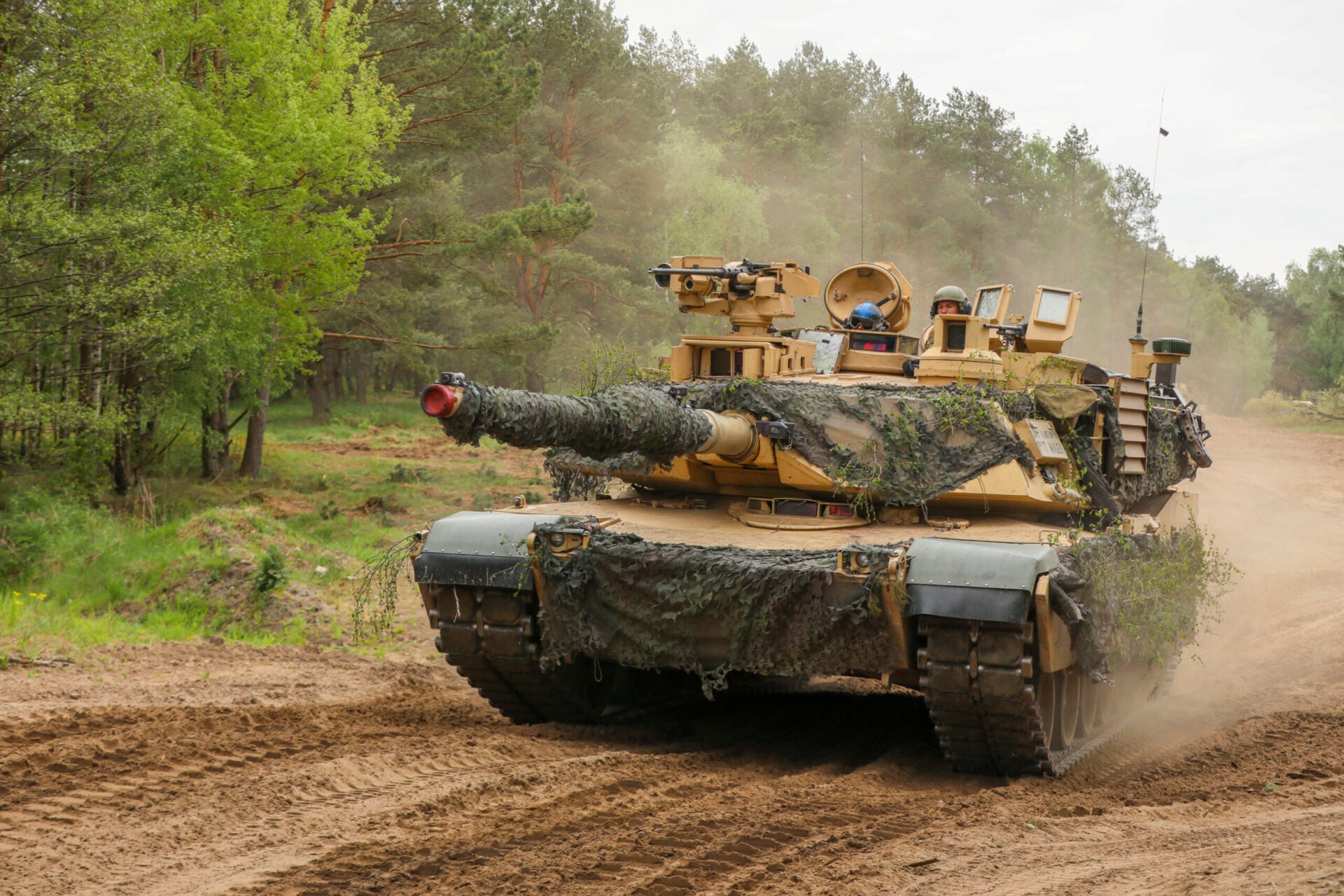
 www.thedrive.com
www.thedrive.com
Amerikassa siis kiirehditään Puolan tankkivajauksen täyttöä, kun T-72:ia on lahjoitettu Ukrainaan. Lend-Lease-lain käyttö on harkinnassa.

U.S. Army Could Use New Lend-Lease Act To Speed M1 Abrams Tanks to Poland
Poland wants modern replacements for the 240 older tanks it has donated to Ukraine, but won't currently get U.S. M1s until 2025.
U.S. Army Could Use New Lend-Lease Act To Speed M1 Abrams Tanks to Poland
Poland wants modern replacements for the 240 older tanks it has donated to Ukraine, but won’t currently get U.S. M1s until 2025.
byDan ParsonsMay 18, 2022 5:42 PM
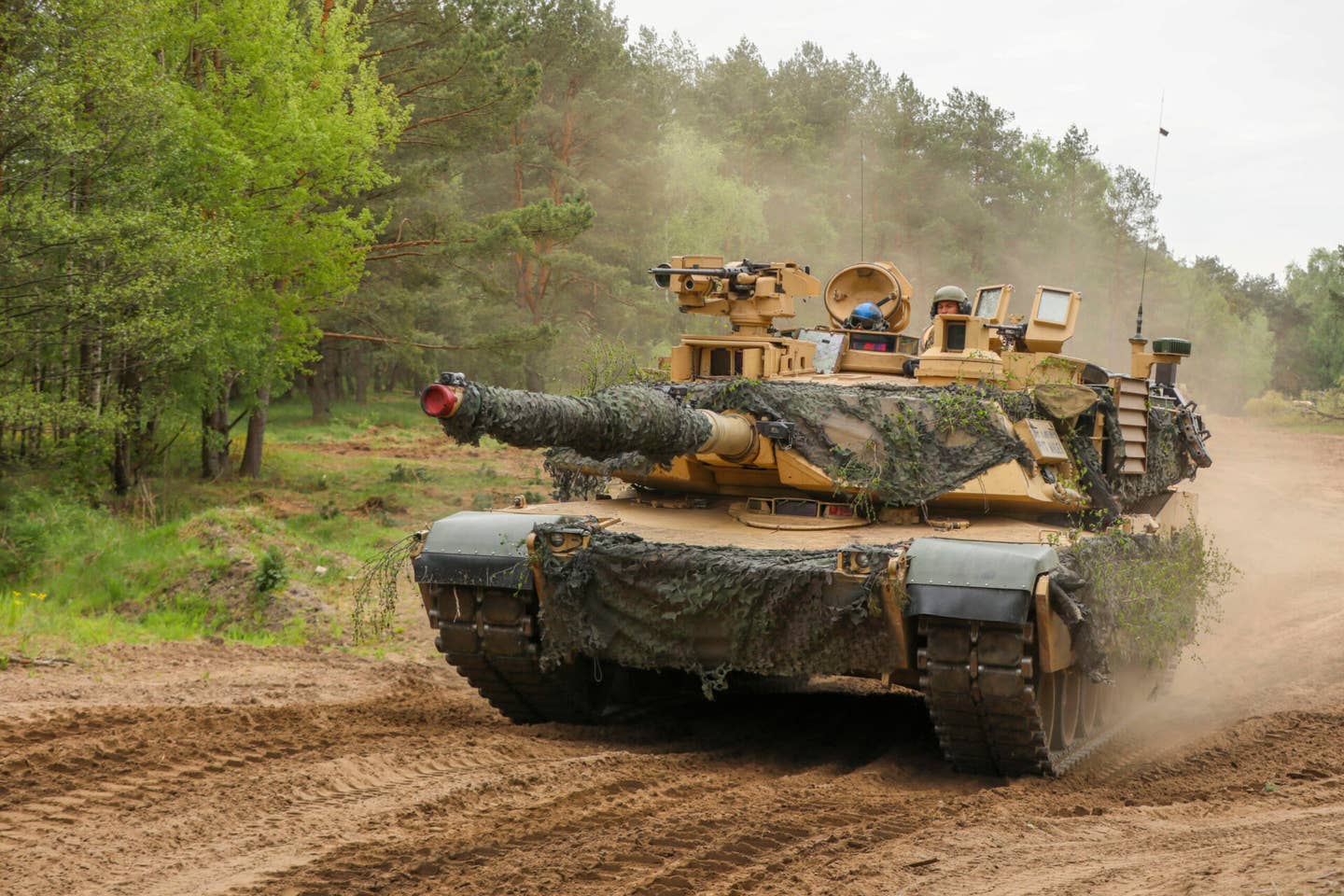
Share
Dan ParsonsView dan parsons's Articles
The U.S. Army is weighing options for fast-tracking the delivery of M1 Abrams tanks to Poland to boost the NATO nation’s armor capabilities and replace old tanks donated to Ukraine for use in the war against Russia. Through new pathways opened by Congress, including the recently revived Lend-Lease program, Poland could take possession of U.S.-built armor years ahead of current schedules, the Army’s chief weapon buyer told lawmakers yesterday.
Having already donated about 240 Soviet-era T-72 tanks to Ukraine, Poland needs U.S. tanks sooner than 2025 to “backfill” its armor capabilities, Rep. Mike Turner, an Ohio Republican, said during a May 17 hearing of the House Armed Services Subcommittee on Air and Land Systems. The Polish government signed a foreign military sales deal in April with the U.S. to buy the 250 M1A2 SEPv3 Abrams tanks for $4.75 billion, but under the current schedule those tanks won’t show up in Poland until late 2024 or early 2025, Turner added. His district includes the Army's Joint Systems Manufacturing Center, also known as the Lima Army Tank Plant, where these tanks are made.
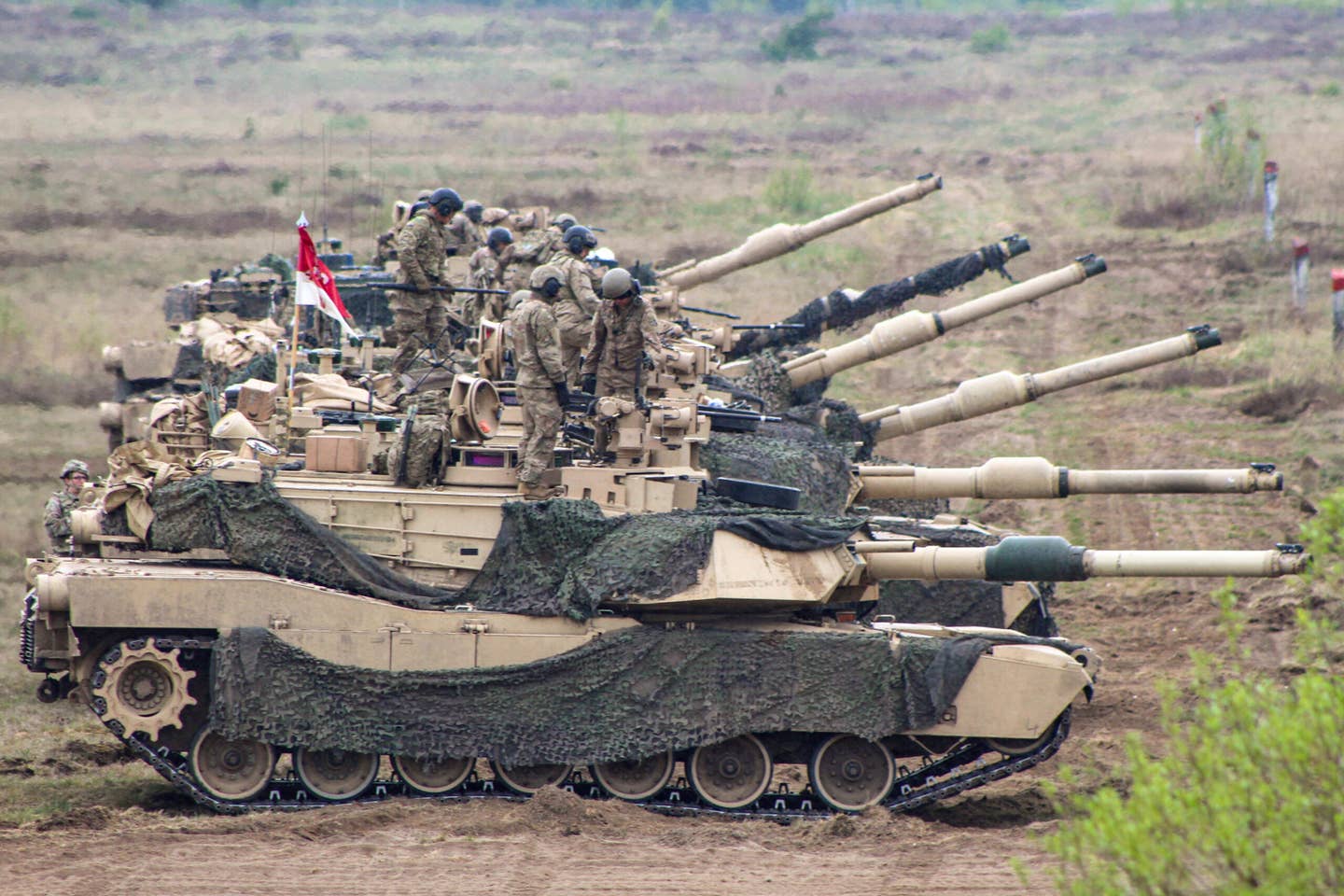
U.S. Army M1A2 Abrams tanks at Mielno Range in Drawsko Pomorskie, Poland, in May 2022. U.S. Army National Guard photo by Spc. Hedil Hernández
“In terms of acceleration, there are options,” Assistant Secretary of the Army for Acquisitions, Logistics, and Technology Doug Bush told Turner and other members of the House Armed Services Committee in response. “It could involve, for example, prioritizing deliveries to them a little bit ahead of the U.S. Army or other allies. Those are dials we can turn. The Army is normally not the one to decide that. That would normally be [the Office of the Secretary of Defense]. But that is one option.”
Bush said the Army could deliver the tanks and other vehicles through the recently-passed Ukraine Democracy Defense Lend-Lease Act. That law provides explicit authority for transfers of U.S. arms to Ukraine, but also mentions helping other "Eastern European countries impacted by the Russian Federation’s invasion of Ukraine," which would include neighboring Poland. The stated goal of that assistance would be “to help bolster those countries' defense capabilities and protect their civilian populations from potential invasion or ongoing aggression by the armed forces of the Government of the Russian Federation," the legislation states. You can read all about this new Lend-Lease program here.
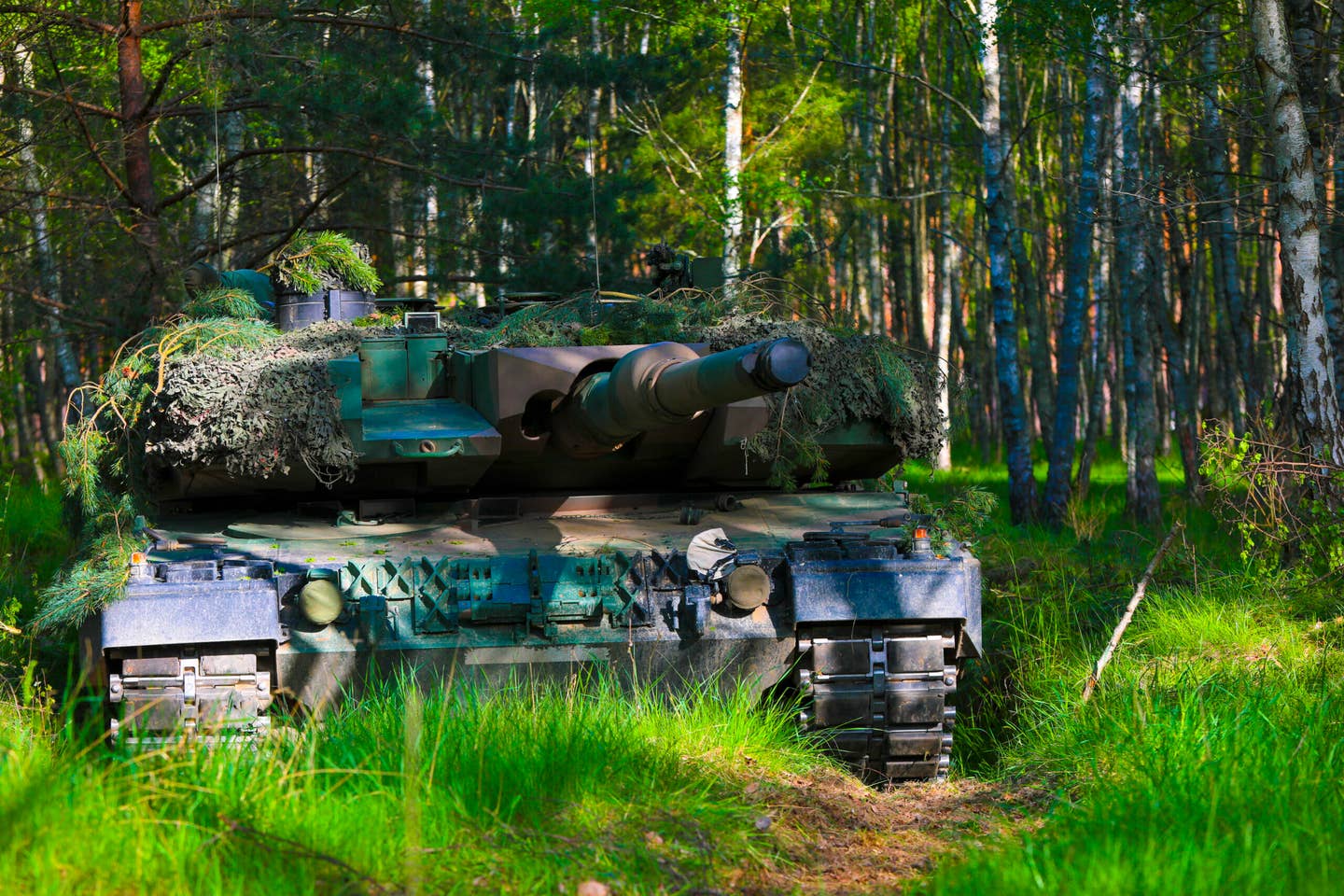
A Polish Leopard tank pulls security during their multinational field training exercise as part of Defender Europe 2022, Drawsko Pomorskie, Poland, May 15, 2022. U.S. Army photo by Sgt. Andrew Greenwood
Using the new Lend-Lease act is one of several ways the Army is trying to “think creatively about how we could provide them with tanks in the interim,” Bush added. “Those are very nascent conversations, though, so I would have to come back to you with more detail in the classified space or to give you the whole story.”
In the meantime, U.S. troops are preparing to train their Polish counterparts to operate and maintain the tanks before the vehicles arrive in Europe, Bush said. That should give Poland a leg up on getting the M1s into the field when they do show up.
“Another thing we're doing to try to enhance cooperation with Poland is, in the meantime, establishing a training activity with them to allow for at least initial familiarization training with U.S. soldiers on Abrams tanks in Poland,” Bush said. “Those efforts are underway … to try to get them a head start on the people-side of operating an Abrams tank and doing logistics.”
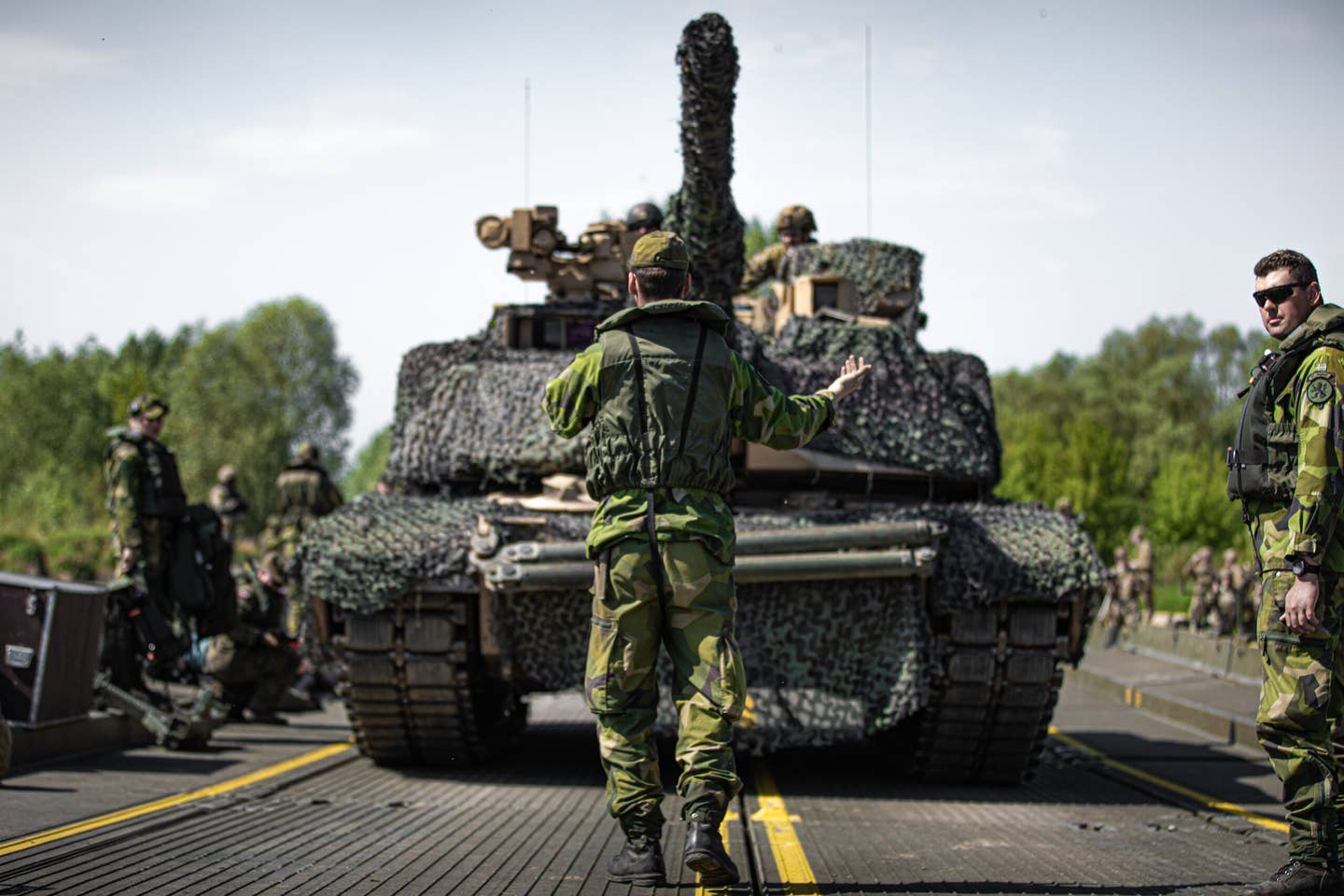
A Swedish soldier guides a U.S. Army M1A2 Abrams tank during a wet-gap crossing at Dęblin, Poland, in May 2022. U.S. Army National Guard photo by Sgt. Agustín Montañez
Poland sent at least 240 of its T-72s to Ukraine, enough to equip two brigades as the country battles an ongoing open-field Russian onslaught in the east, The Wall Street Journal reported in late April. That transfer did not totally deplete its armor capabilities, however. The Polish Army operates hundreds of several variants of the more-modern Leopard 2 tanks it received from Germany beginning in 2002. It also has domestically modernized T-72 derivatives called the PT-91 Twardy in service.
Poland has sent artillery and multiple-launch rocket systems from its own stocks along with the tanks to Ukraine, the Wall Street Journal reported. Driven largely by concerns about Russian aggression, Poland has been working to modernize its military for years now.
The M1 Abrams purchases are one component of that modernization. The U.S. military had first announced that the U.S. State Department had signed off on the proposed sale of 250 of these tanks to Poland in February. Those tanks would be part of a larger approved $6 billion package that also includes 250 AN/VLQ-12 CREW Duke counter-IED systems, 26 M88A2 HERCULES Combat Recovery vehicles, 17 M1110 Joint Assault Bridges, weapons, ammunition, training and service support.
“This proposed sale will support the foreign policy and national security of the United States by helping to improve the security of a NATO ally that is a force for political stability and economic progress in Europe,” the U.S. Defense Security Cooperation Agency (DSCA) said in an announcement of the tank deal with Poland in February. “The proposed sale will improve Poland’s capability to meet current and future threats by providing a credible force that is capable of deterring adversaries and participating in NATO operations.”
DSCA also noted that “there will be no adverse impact on U.S. defense readiness as a result of this proposed sale.”
Both Bush and Turner said the Lima Tank Plant can handle additional orders of tanks above what the Army is on contract to receive on current production timelines. The facility is currently churning out 15 Abrams tanks per month, Bush said. With its current workforce, the plant could ramp production to satisfy both U.S. and Polish demands for tanks, Bush said. He did not say how quickly the ramp-up could be achieved.
“That plant is a national treasure, one of a kind. It’s critical to everything the Army does,” Bush said. In terms of the industrial base itself, it's great to see the plant at 15 tanks a month. I remember when we were fighting to keep it at one tank a month. But I know it can do more, and I know that the workforce can do more. If the army continues to invest … that'll help the industrial base, broadly. Simply put, the more tanks going through there, the healthier the industrial base that feeds it.”
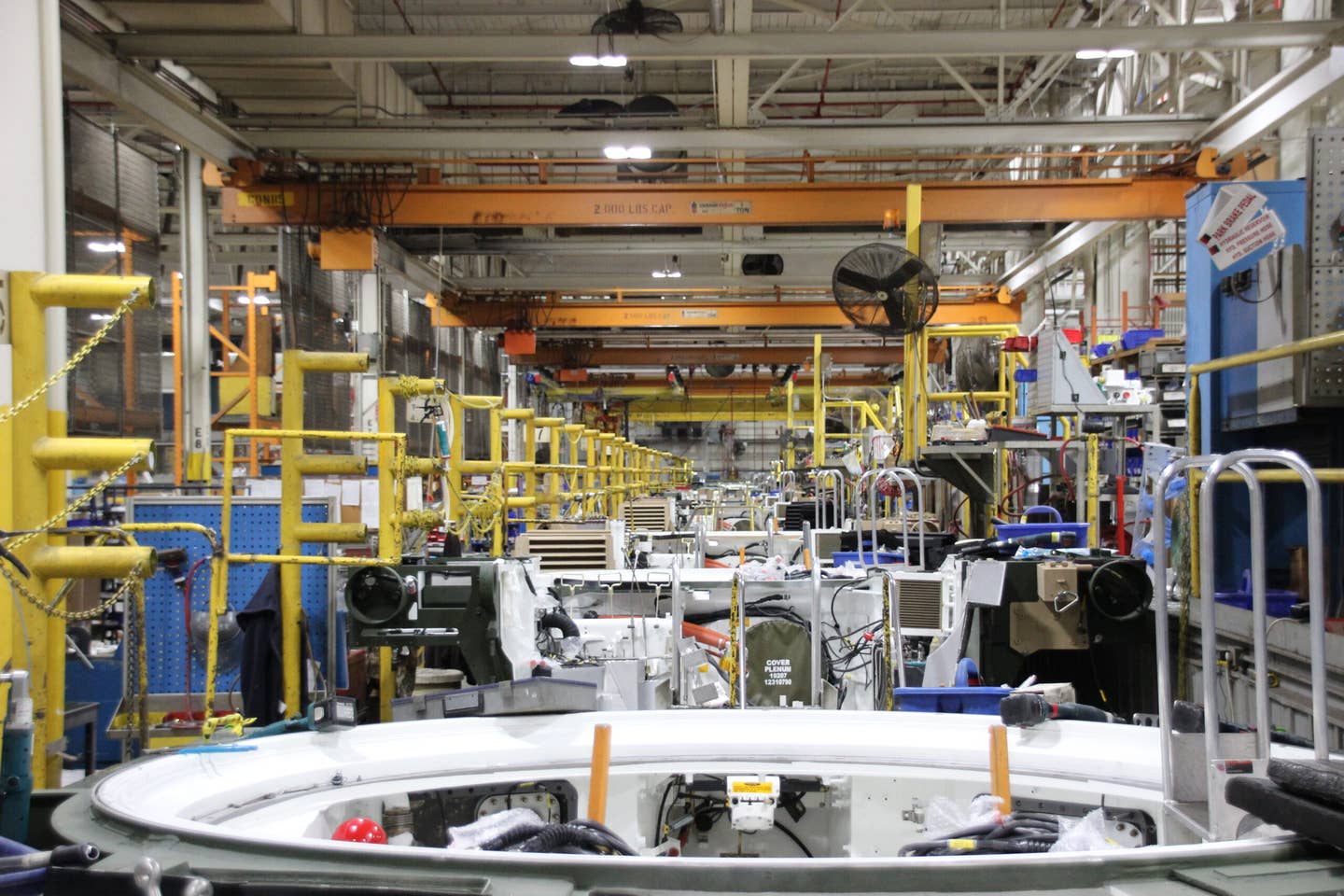
A look down the M1 Abrams assembly line at the Joint Systems Manufacturing Center-Lima, commonly called the Lima Army Tank Plant, in Ohio. U.S. Army Tank-automotive and Armaments Command photo by Brian Hahn
The Army cut how many tanks it would buy from 102 in fiscal 2023 to just 22, in what Bush called one of the "more difficult decisions" of balancing its budget. After it submitted its budget for the fiscal year that begins Oct. 1, the Army sent Congress an unfunded priorities list that included, very near the top, another $524 million for Abrams tank modernization.
"I think that prioritization reflects the Army's view of how important it is," Bush said. "if we can get help there, the Army would be glad to accept it. And we are ready to execute and to crank that production line up even more than it already is."
Backfilling European military capabilities and capacity as a result of donations to Ukraine has already become an issue. Poland specifically has received stopgap assistance from NATO allies to close its capability gaps until replacement equipment arrives or is built. Polish Prime Minister Mateusz Morawiecki confirmed a plan by the U.K. to send an undisclosed number of Challenger 2 tanks to fill the capability gap opened by Poland donating its military equipment to Ukraine. Unlike the U.S. sale of M1, the British tanks will deploy on a short-term basis and be operated by British crews.
NATO nations have rallied behind Ukraine and poured weapons into the fight but now find themselves needing an infusion of military capacity. Propping up Ukraine's fight against Russia now has had a spillover effect of boosting, or at least accelerating, sales of military equipment to other countries in the region. Through the new Lend-Lease Act, it appears nations backing Ukraine now have a new pathway to purchasing U.S. military kit.
tulikomento
Supreme Leader
Leaderwolf
Respected Leader
Panther KF51 main battle tank
-APEX predator-The Panther fulfils the core capability of “dominate and destroy”.
-Rarely has the sheer power of an MBT gun been more impressive. The Future Gun System, developed by Rheinmetall, enables a 50 per cent longer kill range to be achieved (than 120 mm) with an unrivalled rate of fire due to the autoloader performance.
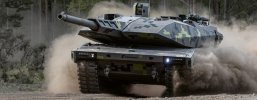
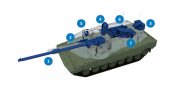
https://www.rheinmetall-defence.com...oured_tracked_vehicles/panther_kf51/index.php
Einomies1
Respected Leader
Mmm. En tosiaankaan havittelisi uusinta uutta suomeen, vaikka Panther henkiinherätettynä on näyttävä ja varmasti suorituskykyinen tuote.Tämä Saksan penseys on tosiaan kysymysmerkki meillekin. Vaikka periaatteessa tällaisia järjestelmiä hankittaessa pitäisikin huolehtia siitä, että ylläpitoon tarvittavat kyvyt ja materiaali löytyvät omasta takaa, niin sota-ajan täydennyksien varaan ei ilmeisesti kannata liikaa laskea nykyisen Saksan kanssa.
Sinänsä Leopard 2A4:n kohtaloa kannattaa pohtia varmaan vasta, kun Nato-jäsenyydestä ollaan paremmin kartalla. Päivitykset (saati uudet vaunut) olisivat kalliita ja pois jostakin muualta. Samaan aikaan mahdolliset Nato-vahvistukset olisivat luultavammin mekanisoituja joukkoja kuin mitään hirviprikaati-porukkaa.
Toisaalta jos Nato-jäsenyys jää roikkumaan pidemmäksi aikaa, niin voi olla, että lisäbudjetteja joudutaan tekemään lisääkin nykyisten päälle. Silloin kysymyksestä tulee ajankohtaisempi. Mutta onko ratkaisu silloinkaan Leopard-päivitys vaiko jotakin muuta? Uusinkin Abrams olisi joiltakin osin downgrade nykyiseen Leopard 2A6:een nähden, vaikka Puola tähän päätyikin. Mutta K2 Black Panther saattaa olla kilpailukykyisesti hinnoiteltu ja siinä on joitakin kiinnostavia ominaisuuksia (mm. automaattilaturi, omasuojajärjestelmät, adaptiivinen jousitus, varusmiesarmeija-yhteensopivuus) - riippuen toki hieman siitä, miten vaunun kanssa käy lopulta Puolassa ja Norjassa (Wikipedian mukaan Norjassa on vastakkain Leo 2A7 ja K2, päätöstä odotetaan loppuvuodesta 2022).
Sensijaan 2A4 vaunujen säilyttäminen ja modernisointi nostaa yhä enemmän päätään, kuten anti-drone torjuntakin. Kallista kaikki tyyni, mutta uusien vaunujen hankinta on ihan omaa luokkaansa ja jopa Bundeswehrin Leo 2A7 versio on varmaan sitä 10 miljoonaa+ luokkaa. Nyt vielä hinnat nousevat raketin lailla. Vanhan pimppaaminen voi nousta arvoon arvaamattomaan, kun sitä rahaa palaa lisäbudjetista huolimatta ammuksiin ja ohjuksiin sekä suojavarusteisiin ym.
Leo 2A4 voitaisiin suojan osalta päivittää aivan varmasti suomessakin. Osa toki vaatii valmistajan tukea Saksasta:
Esim, suomessa:
- miinasuojalevy pohjaan (n. 2tn)
- tornin top-attack suojaus komposiitilla
- ajajan lämppäri/valonvahvistin (Senop)
- peruutuskamera+kamerat ympärille
Rheinmetall / IDB Deisenroth:
- tornin sähköistys (kallein)
- AMAP-panssari keulaan ja tornin eteen / sivuille
- lämpötähtäinten päivitys III gen Attica
- laservaroitusjärjestelmä (myös Leo 2A6fin)
Kotimaista osaamista löytyy kyllä:
https://fy-composites.com/fi/
https://www.flinkenberg.fi/steel/
https://conlog-group.fi/
https://senop.fi/defence-security/vehicle-vision-systems/
edit. vielä jää ammusten järjestelyn parantaminen vaunun sisällä ja spall-liner tekemättä

- Liikkuvuus vaikuttaa selvästi paremmalta.
Tämä on jo vittuilua Uralvagonzavodia kohtaan!

Pekka Toverin arvio tiivistettynä: "Ihan kuin Armata, suurin ero että saattaa jopa oikeasti toimia."
Huhta
Greatest Leader
The Drive tarttui Pantheriin.
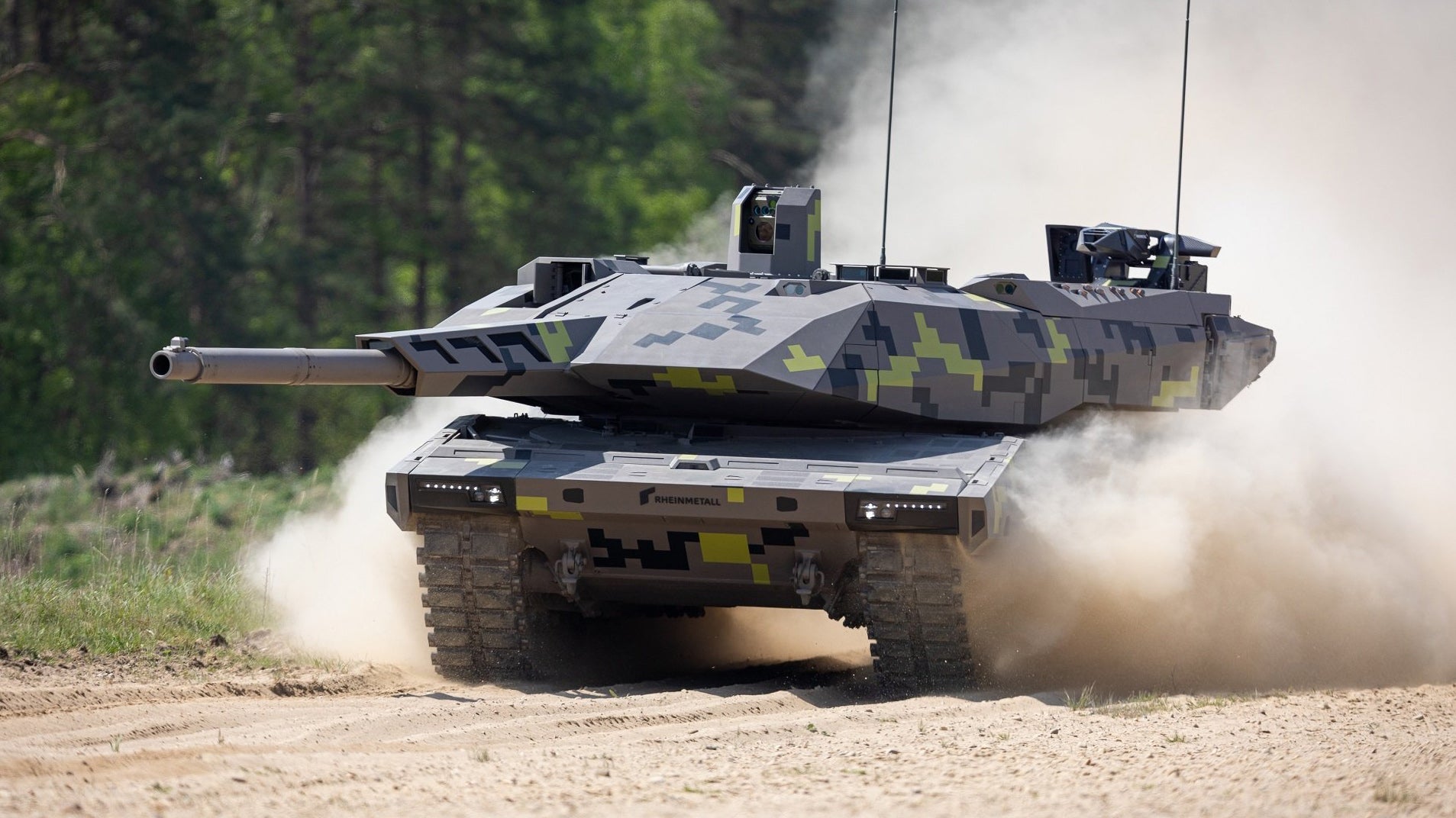
 www.thedrive.com
www.thedrive.com

New KF51 Panther Tank Packs Big 130mm Gun Aimed At Aging Leopard 2
Germany’s Rheinmetall has unveiled its KF51 Panther that could disrupt Franco-German plans for a new main battle tank.
New KF51 Panther Tank Packs Big 130mm Gun Aimed At Aging Leopard 2
Germany’s Rheinmetall has unveiled its KF51 Panther that could disrupt Franco-German plans for a new main battle tank.
byThomas NewdickJun 13, 2022 1:00 PM

Rheinmetall
Share
Thomas NewdickView thomas newdick's Articles
CombatAir
With tank warfare very much back on the agenda as the war in Ukraine rages on, Germany’s Rheinmetall company today unveiled its latest main battle tank, the KF51 Panther, armed with a huge 130mm caliber main gun. This private-venture design is aimed as a long-term successor to the widely used Leopard 2 within the German Army but may well attract interest from other European countries looking at the future of their own armored forces as they reconfigure to face the threat of an increasingly belligerent Russia.
The KF51 Panther, the name of which recalls the legendary Nazi German tank of World War II, was presented today at the Eurosatory land defense exhibition in Paris, by Rheinmetall CEO Armin Papperger.
So far, the company has released very little in the way of information about the new MBT and its specifications. The tank reportedly weighs around 65 tons. This makes it lighter than the Leopard 2, which, in its latest 2A7V form, tips the scales at a little over 70 tons, according to the German Army. Powered by the same 1,475-horsepower diesel engine, that should help to ensure the Panther has improved mobility compared to its predecessor. Overall, the Panther is lighter than a lot of current Western MBTs, notably later versions of the U.S.-made M1 Abrams, with an overall weight, in combat, of over 70 tons. It is perhaps only a little surprising that the designers did not opt for a more modern propulsion arrangement, such as a hybrid powerplant, but the chosen solution should make it quicker and easier to develop and produce.
The new MBT also has its firepower boosted, thanks to a smoothbore 130mm caliber main gun, compared to the 120mm weapon on the Leopard 2. This reflects a broader interest in moving to increased-caliber tank armament and the gun itself is something that Rheinmetall has been working on for some time now. According to Papperger, the 130mm gun is “more than 50 percent more effective” than the Leopard 2’s gun and will offer “much longer range.” It will fire both kinetic-energy saboted projectiles and programmable explosive ammunition.
Other armament is planned to include a 12.7mm coaxial machine gun and an optional remote-controlled weapon station. There will also be provisions for launchers for HERO 120 loitering ammunition, drones, and undisclosed missiles, perhaps of a type that would provide localized air defense since there is no mention, so far, of an anti-aircraft machine gun.
In terms of protection, there are few details of what the Panther offers, although Rheinmetall has asserted that the crew will be better protected than in the Leopard 2 and will benefit from active, reactive, and passive protection technologies. The Rheinmetall StrikeShield active protection system will be fitted to defend against threats such as anti-tank weapons and suicide drones. Originally known as APS-Gen3, StrikeShield was the first system of its kind to pass a stringent independent safety evaluation. That should have helped allay potential customers’ fears that these types of defenses might pose significant risks to friendly troops and innocent bystanders.
While the Leopard 2 has a crew of four, this is reduced to three in the Panther (commander, gunner, and driver) aided by the introduction of an autoloader to feed ammunition to the main gun. An additional fourth crew member can be included if required, for example, an additional specialist or platoon commander.
The crew will be provided with digital networking capabilities to be more effective on the battlefield and each soldier will also have access to data from all sensors, weapons, powerpack, and other subsystems, which can be called up as required. With each crew member able to take over tasks from the others, the tank also lends itself to be configured with unmanned turrets in the future, Rheinmetall says, and perhaps even a version that’s entirely unmanned.
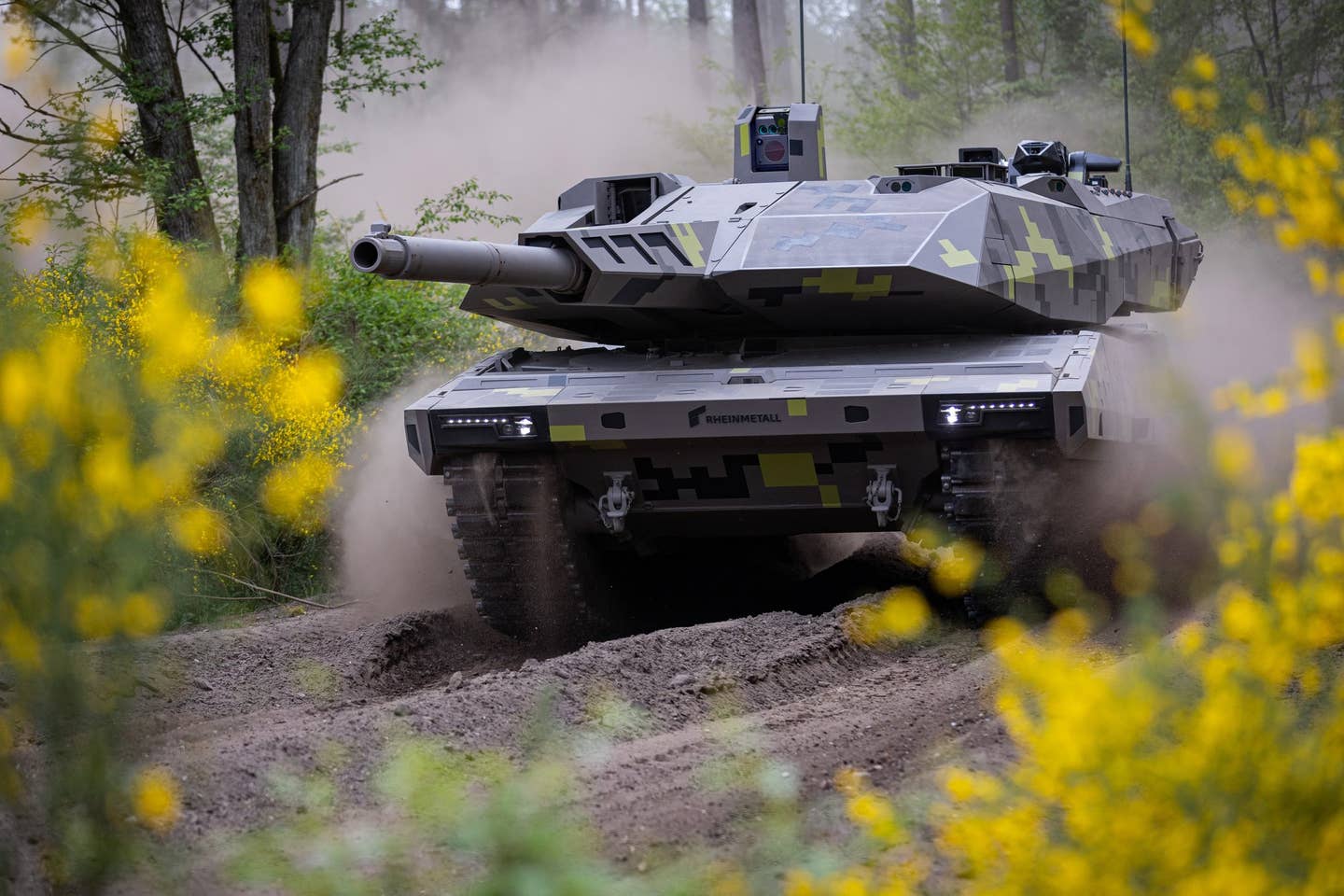
An artist’s concept of the KF51 Panther. Rheinmetall
Overall efficiency will also be enhanced thanks to an open-architecture system known as NATO Generic Vehicle Architecture (NGVA), allowing rapid integration of sensors and weapons and improving general interoperability with other platforms.
It is somewhat ironic that the Panther is making its debut in France since the fortunes of the MBT could well influence the future of tank forces in both France and Germany.
Under the Main Ground Combat System, or MGCS, the governments in Paris and Berlin are investing around $1.6 billion in development costs to create a new Franco-German MBT that will eventually replace the French Army’s Leclerc and German Leopard 2s. The MGCS brings together Nexter of France with the other giant of the German land systems industry, Krauss-Maffei Wegmann (KMW), within a partnership known as KNDS. Rheinmetall is also involved in MGCS. Reports in the German media suggest that the company is unhappy with its status in the program, in which KNDS is said to be the lead partner.
With that in mind, the Panther could well be Rheinmetall’s response to its dissatisfaction with the path that MGCS is taking and it’s significant that it’s not only striking out on its own but also that it has developed its new MBT so rapidly. That should serve as a signal to both the German government and also to other countries potentially now looking to overhaul their tank fleets, with the security situation in Eastern Europe worse than it has been for many years.
If Rheinmetall can bring to market an MBT that offers similar firepower to the MGCS, but do so quickly, it might be able to secure both domestic orders and interest from export customers. The Leopard 2 has been a huge export success, especially in Europe, and Rheinmetall should be well placed to capitalize on that. The Asia Pacific region, too, is another possible market for MBTs. Interestingly, however, the company appears to be aiming primarily at the German market, initially at least, perhaps with the hope that Berlin might be more receptive to an all-German replacement for its Leopard 2s. That would clearly undermine the Franco-German MGCS.
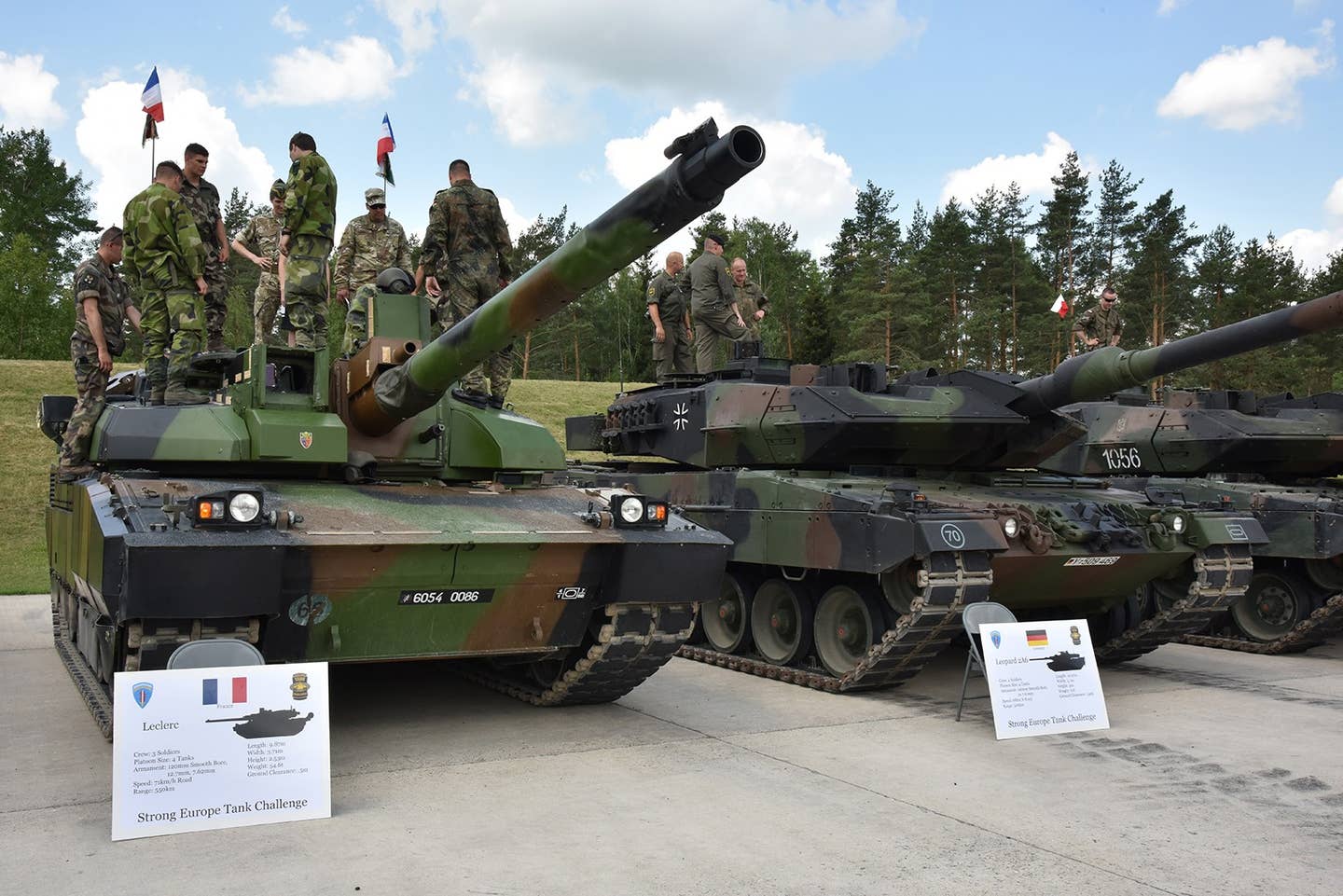
A French Army Leclerc and a Germany Army Leopard 2A6 during an inspection ahead of the Strong Europe Tank Challenge, held at the U.S. 7th Army Training Command’s Grafenwoehr Training Area, Germany, in 2018. U.S. Army
It’s notable that at least one other major defense project, the Future Combat Air System (FCAS), in which France and Germany play the leading roles, is currently struggling. Recent reports suggest that the airpower system, which will include a manned fighter jet as its centerpiece, has been delayed. Once expected to enter service in 2040, the fighter is not likely to be operational until 2050, according to Dassault CEO Éric Trappier. In the meantime, Germany has announced plans to buy F-35A stealth fighters, a move that has led to dismay among French officials.
The timing for a Leopard 2 successor for the German Army is perhaps fortuitous. As Berlin responds to the conflict in Ukraine by embarking on military modernization, a “special fund” from the 2022 budget amounting to over $112 billion has been earmarked for buying new equipment. At the same time, German Chancellor Olaf Scholz has underlined his promise of increasing defense spending to 2% of gross domestic product, in line with NATO aspirations.
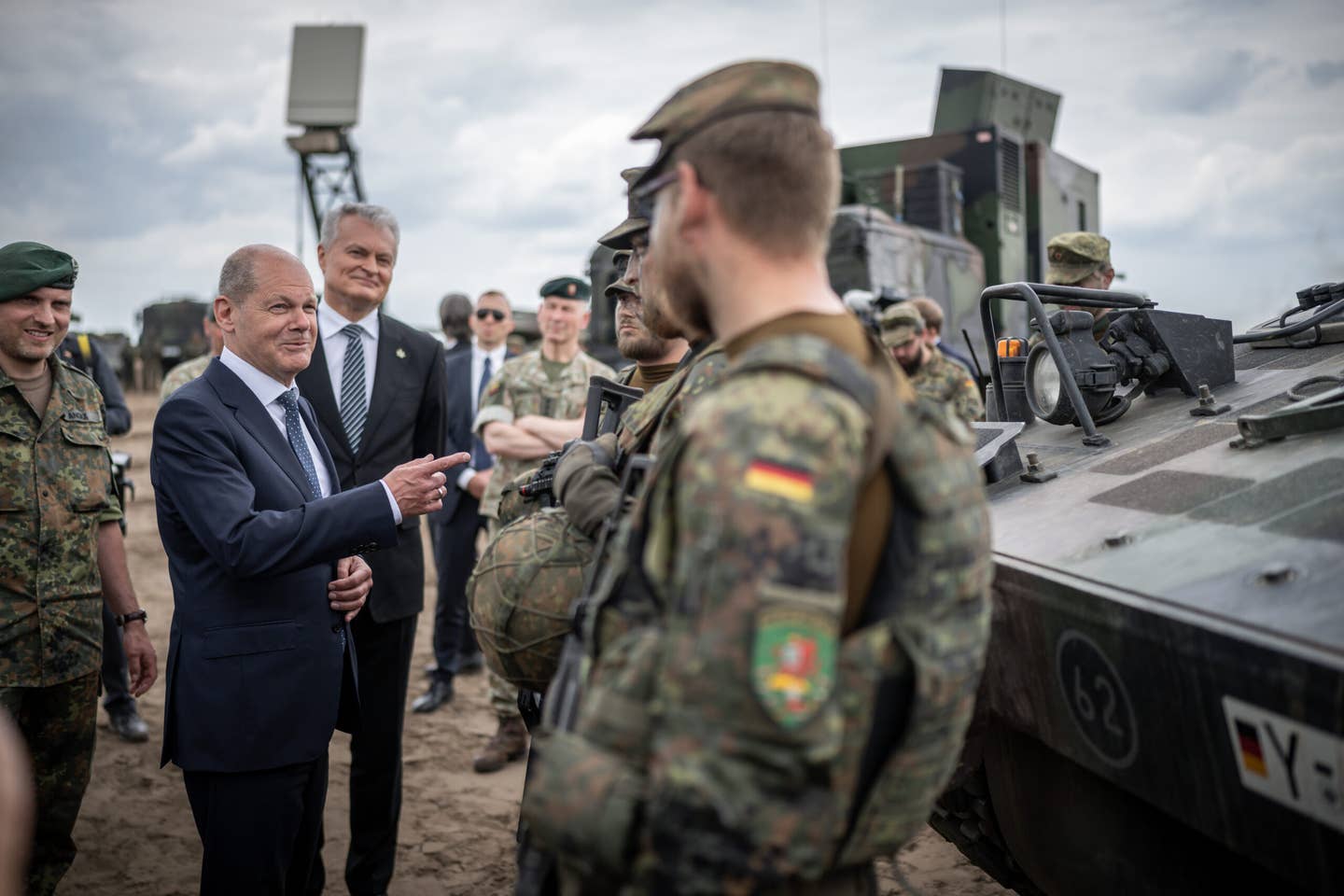
German Chancellor Olaf Scholz speaks with soldiers alongside Gitanas Nauseda, President of Lithuania (third from left), at Camp Adrian Rohn, Lithuania, where more than 1,000 German soldiers are currently stationed as part of the NATO Enhanced Forward Presence Battle Group. Photo by Michael Kappeler/picture alliance via Getty Images
With tank warfare a prominent feature of the fighting in Ukraine, so far, it’s possible that buying new MBTs sooner rather than later could be on the agenda. Here the Panther would appear to have an advantage over the MGCS, which was due to arrive in service beginning in 2035. While a technology demonstrator for the MGCS program, the Enhanced Main Battle Tank, combining Leclerc and Leopard 2 components, was unveiled in 2018, progress since then has been slow.
Outside of Germany, meanwhile, other nations closer to Russia’s borders are also looking at bolstering their land forces, in particular, to help dissuade potential aggression from Moscow. Reports in the German media suggest that at least one country in Eastern Europe has expressed interest in the new MBT. For some countries in this part of the world, especially some NATO members, the need for new armor has proven even more urgent. Poland, which at one time was suggested as a possible MGCS customer, instead opted for 250 U.S.-made M1A2SEPv3 Abrams tanks and is now looking to accelerate deliveries after delivering surplus Soviet-era T-72s to Ukraine.
The war in Ukraine has already led to a flurry of tank transfers and deliveries around Europe, as countries provide Kyiv with surplus armor from their own stocks. While Germany has been notably slow off the mark when it comes to delivering secondhand MBTs to Ukraine, the reconfiguration of tank fleets elsewhere in Europe could mean that they require back-filling. For instance, the Czech Republic is receiving 15 surplus Leopard 2A4 tanks from Germany to replace T-72s that it donated to Ukraine, and it might follow up with orders for 50 additional Leopard 2A7+ tanks. Potentially, other countries will also take the opportunity to buy new tanks, with the Panther being one possible candidate.
The conflict in Ukraine has prompted a renewed discussion about the future of the tank in general. While heavy armor has played a major part in its traditional breakthrough role, the vulnerability of MBTs to various weapons has been highlighted too. In some ways, the KF51 Panther seems to be trying to address those realities from various different angles. Overall, it should be lighter and more agile than current MBTs, carry a bigger main gun, and have the ability to provide stand-in surveillance and strike with loitering munitions.
All in all, the KF51 Panther arrives on the scene at a very interesting time in tank warfare, and ultimately, it could help shape the future of MBT forces both in Germany and elsewhere.
ei ainoastaan pantheriin, vaan mukana oli dronet, drone tankki, joka hoitaa myös koko pumpun yhteyden pitoa ja toimii hubina sensorifuusioidussa verkossa. APS oli suuresti esille.The Drive tarttui Pantheriin.
Miksi EU voi pistää tilausta 5000 Kf51selle, ja muodostaa siitä 40 - 50 luvulle asti ulottuvan selkärangan EUn fleetille. Optiot toiselle 5000, mutta sitten että se voidaan räätälöidä tarpeisiin nähtäväksi myös uusilla malleilla. Leo2sia ja muita voisi vapauttaa konfliktiin kun sakuilla on tilauskirja täynnä ja EUn valtiot ymmärtävät että kaikki saavat jotakin.
Huhta
Greatest Leader
ei ainoastaan pantheriin, vaan mukana oli dronet, drone tankki, joka hoitaa myös koko pumpun yhteyden pitoa ja toimii hubina sensorifuusioidussa verkossa. APS oli suuresti esille.
Miksi EU voi pistää tilausta 5000 Kf51selle, ja muodostaa siitä 40 - 50 luvulle asti ulottuvan selkärangan EUn fleetille. Optiot toiselle 5000, mutta sitten että se voidaan räätälöidä tarpeisiin nähtäväksi myös uusilla malleilla. Leo2sia ja muita voisi vapauttaa konfliktiin kun sakuilla on tilauskirja täynnä ja EUn valtiot ymmärtävät että kaikki saavat jotakin.
EU:lla ei ole armeijaa.
Eikä me suomalaiset haluta mitään yhtäaikaa neljättä valtakuntaa rakentavia ja samaan aikaan nurkassa kyyhöttäviä saksalaisvaunuja. Kuten Nancy Reagan totesi: "Sano vain EI."
Sieltä se terminaattori sitten lopulta tulee:
Nyt se autoloaderi sitten onkin yhtäkkiä hyvä juttu ?
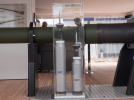
Yleisesti lienee konsensus, että 120mm on aikalailla isoin ammus, jota ihminen käsittelee tankin sisällä tehokkaasti. Sen myötä myös lännessä ollaan entistä enemmän siirtymässä automaattilataajaan. Automaattilataajan hyvät ja huonot puolet ovat edelleen olemassa. Toki yleinen elektroniikan kehitys tekee esim. miehittämättömästä tornista (vaatii automaattilataajan) realistisemman vaihtoehdon. En toki usko, että se tulee toteutumaan ainakaan venäläisen elektroniikkateollisuuden toimesta tällä vuosisadan puolikkaalla.
